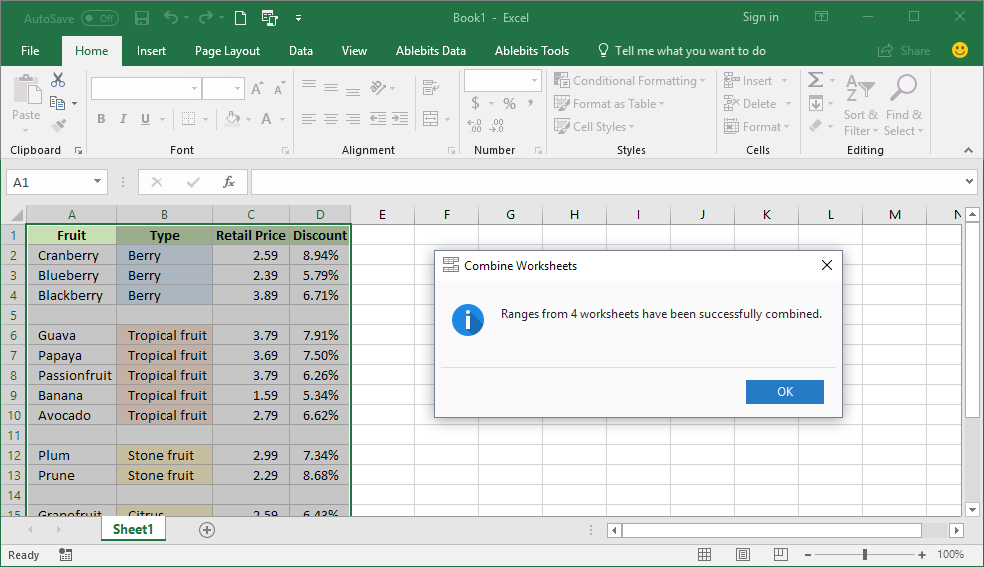5 Ways to Merge Excel Sheets into One

Merging multiple Excel sheets into one comprehensive document can be a daunting task, especially if you are dealing with extensive data sets or numerous files. Whether you are compiling reports, aggregating financial data, or just trying to organize information for easier analysis, the need to consolidate data from various sources into a single file is common. In this guide, we'll explore five effective methods to merge Excel sheets, ensuring you can streamline your workflow and enhance data management.
Method 1: Using Excel’s Built-in Functions

Excel offers some powerful tools for consolidating data directly within the program:
- Consolidate Feature: Use this under the Data tab.
- VLOOKUP: Merge sheets by linking common identifiers.
To use the consolidate feature:
- Select the top-left cell where you want to place the consolidated data.
- Go to Data > Consolidate.
- Choose your function (e.g., Sum, Count, Average).
- Select the ranges from different sheets you want to merge.
- Click ‘Add’ for each range, then click ‘OK’.
Example with Consolidate Function:

Suppose you have sales data spread across January, February, and March in separate sheets:
| Sheet Name | Cell Range |
|---|---|
| January | A1:D10 |
| February | A1:D10 |
| March | A1:D10 |

Here’s how to consolidate this data:
- Select A1 on a new sheet.
- Go to Data > Consolidate.
- Set Function to Sum.
- Select January!A1:D10, then February!A1:D10, and March!A1:D10, clicking ‘Add’ for each.
- Choose ‘Top Row’ and ‘Left Column’ if data has labels.
- Click ‘OK’ to merge.
📝 Note: Ensure each data set in sheets is in the same structure for accurate merging.
Method 2: Power Query

Power Query provides a flexible and powerful way to merge data:
- Create queries from multiple Excel sheets.
- Append or Merge data as needed.
Follow these steps:
- Go to Data > Get Data > From File > From Workbook.
- Navigate to your Excel file and select it.
- Choose sheets or tables to import.
- Use ‘Append Queries’ to combine data vertically or ‘Merge Queries’ for horizontal consolidation.
Method 3: VBA Macro

Using VBA (Visual Basic for Applications), you can automate merging:
Here’s a simple VBA script to merge sheets:
Sub MergeSheets()
Dim WS As Worksheet, Rng As Range
For Each WS In ThisWorkbook.Worksheets
If WS.Name <> “ConsolidatedSheet” Then
Union(Rng, WS.UsedRange).Select
End If
Next WS
If Not Rng Is Nothing Then
Rng.Copy Sheet(“ConsolidatedSheet”).Range(“A1”)
End If
End Sub
To use this:
- Open the VBA Editor (Alt+F11).
- Insert a new module.
- Paste the code above.
- Run the macro to merge sheets into a new sheet named ‘ConsolidatedSheet’.
📝 Note: Ensure you have a sheet named “ConsolidatedSheet” in your workbook before running the macro.
Method 4: Third-Party Tools

Various third-party applications can merge Excel sheets:
- Kutools for Excel
- EasyExcel Automation
- Advanced Combine Rows Wizard
These tools offer user-friendly interfaces for merging:
- Download and install the tool.
- Open your Excel file in the tool.
- Follow the wizard to select sheets and define merge parameters.
- Process the merge and save the results.
Method 5: Manual Method

Manual merging is straightforward but time-consuming:
- Open the first Excel file.
- Select and copy the data or specific range from the first sheet.
- Paste this into a new sheet in your master workbook.
- Repeat for each Excel file, ensuring proper alignment of data.
- Adjust headers or structure as needed.
This method is useful for:
- Small datasets or infrequent merging tasks.
- When accuracy can be verified manually.
📝 Note: Manual merging can be error-prone with large datasets; consider automated methods for improved accuracy and efficiency.
To wrap up, merging Excel sheets into one file is crucial for data analysis, reporting, and general organization. Each method discussed provides different levels of automation and complexity:
- Excel’s built-in functions are excellent for straightforward tasks.
- Power Query offers advanced data manipulation capabilities.
- VBA macros automate repetitive merging tasks.
- Third-party tools simplify the merging process with user-friendly interfaces.
- Manual merging allows for personalized control but requires more time and attention.
Can I merge sheets from different Excel files?

+
Yes, you can merge sheets from different Excel files using methods like Power Query or third-party tools.
What if my sheets have different structures?

+
Methods like Power Query or VBA can handle differing structures by transforming or matching data before merging.
Is it possible to automate the merging process?

+
Absolutely, using VBA macros or third-party tools provides an automated solution for merging Excel sheets.